Self-drive Travel Guidelines
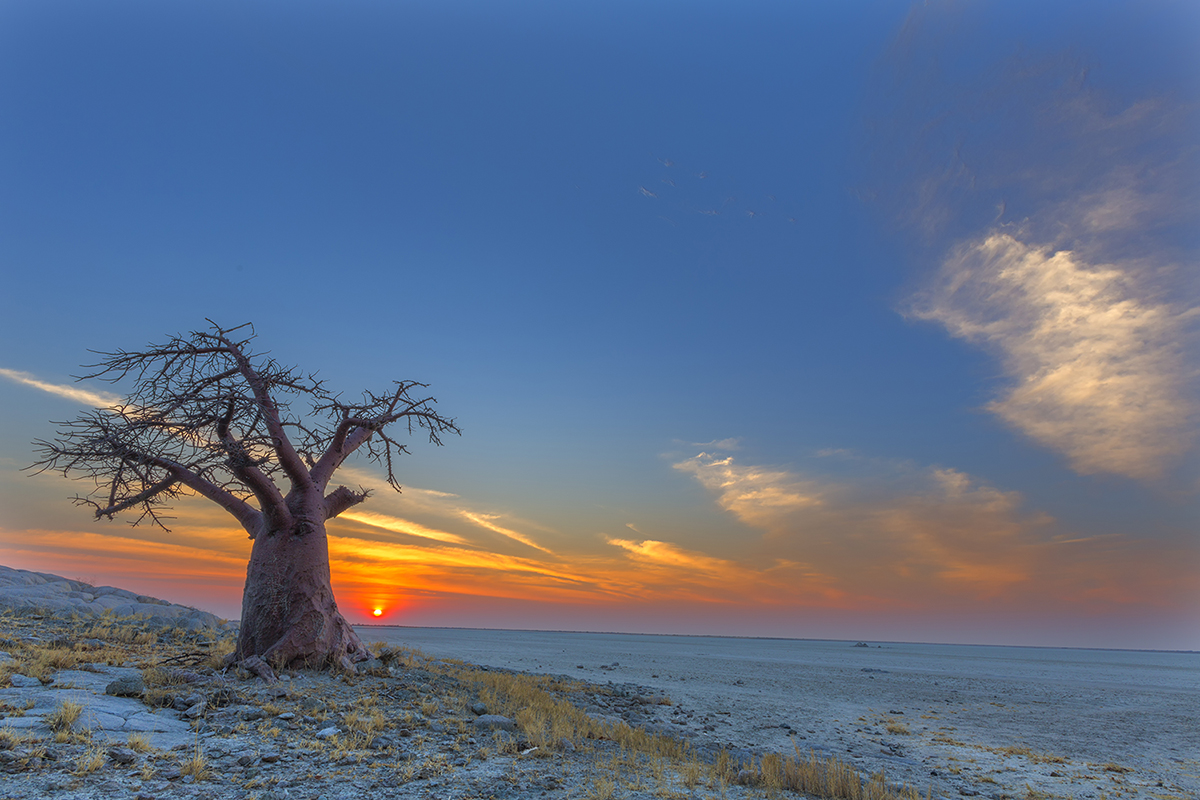
Please read this before you set off on your journey. These tips and guidelines are intended to help you have a safe and enjoyable trip through southern Africa, without becoming part of their road accident statistics.
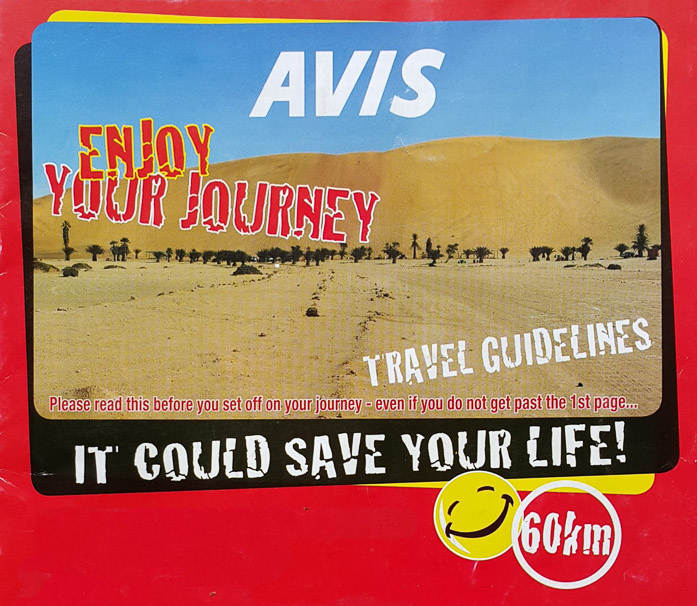
This information comes from an AVIS Travel Guidelines booklet that was produced for the Namibian tourist market as Namibia has some of the worst road accident statistics but these guidelines apply equally to most southern and east African countries and national parks.
Self-drive Travel Guidelines - Some Facts
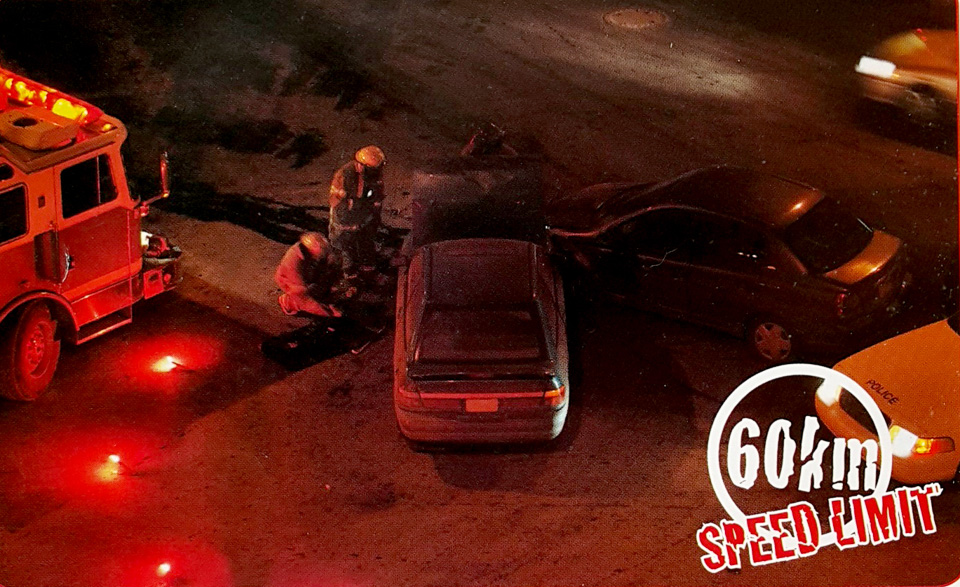
· In Namibia, 1 in 10 tourists have an accident. This statistic is responsible for a lot of spoilt holidays, serious injury and even deaths.
· Despite warnings about the gravel roads being laden with loose stones, self-drive tourists think an accident will not happen to them. Unfortunately IT CAN & DOES!
· The car rental industry has an average of 10 totally wrecked vehicles a month.
·
87% of Namibian roads are gravel
·
95% of accidents in AVIS Namibia vehicles are ‘single
vehicle’ accidents, i.e. not taking due care – no other vehicle, animal or
object is involved, just you and the car, miles from the nearest medical emergency
help.
·
There are hundreds of Namibian car rental tragedy
stories to tell. “We are used to driving on ice in our country” customers say.
It is not the same – it is worse here as our gravel roads offer almost no
traction and we do not have “special
tyres” or the equivalent of snow chains.
·
Regardless whether you drive a 4x4 off-road or
sports utility vehicle (SUV), if you drive too fast – more than the generally
recommended 60 km per hour – and suddenly need to brake because an animal runs
across the road, or you see that you will not make that sudden bend, or become
fatigued and veer off the road – you will brake suddenly, slide, try to
over-correct your steering, lose control and the vehicle is wrecked and your
passengers injured or even killed in just a few seconds.
SO BE WARNED, NOT SCARED – WE ARE JUST ASKING YOU BE AWARE & TO PLEASE ARRIVE ALIVE!
The gravel roads in Namibia are not bad – just the opposite - the Namibian roads are actually some of the best in Africa and because they are in such good condition, it can encourage drivers to drive faster! Rather stick to the speed limits and reach your destination alive!
Gravel Roads
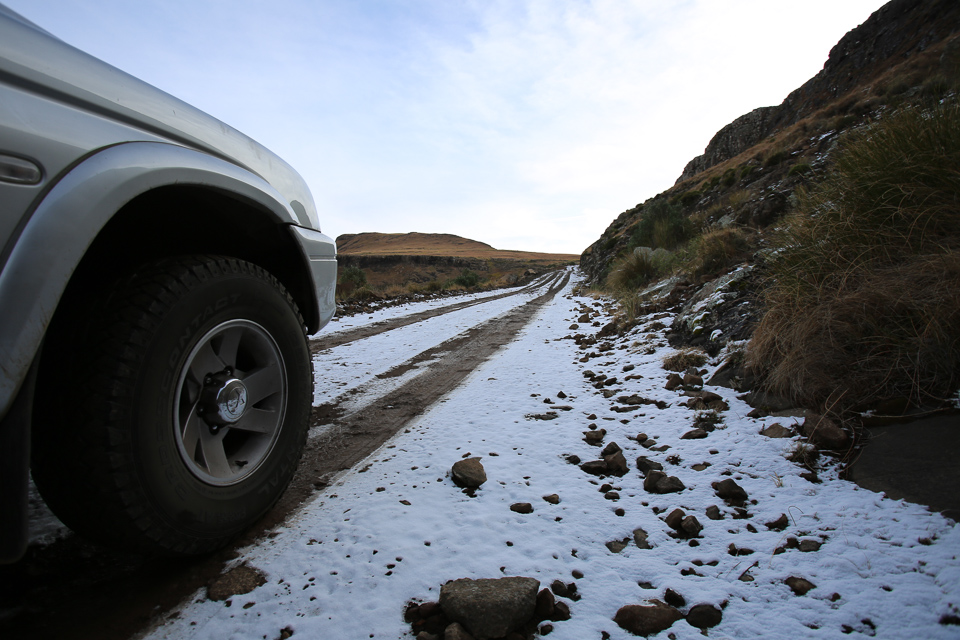
Namibia’s infrastructure includes a major road network consisting of only 13% tarred or sealed road surfaces. The balance is made up of graded gravel roads. Most of the country’s attractions can only be reached by gravel roads. Gravel roads are made by scraping the road surface and compacting stones (gravel) onto this surface.
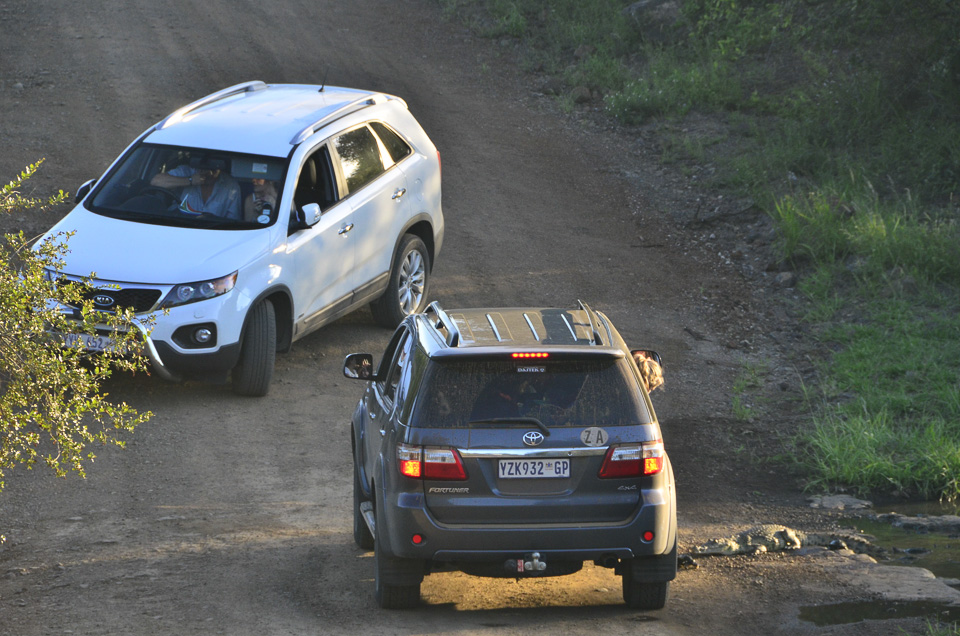 Gravel road in Kruger Park
Gravel road in Kruger ParkAll the roads within Etosha National Park and the Kgalagadi are gravel, most of the roads within Madikwe and Pilanesberg are gravel and the Kruger National Park has 850 kilometers of tarred roads and 1 444 kilometers of gravel roads.
Stones on Gravel Roads
The compacting of stones on gravel roads does not last and you will see tracks forming where the vehicles drive. On the edges of these tracks is where you would encounter stones, which can cause damage to your vehicle’s tyres. There are also stones in the tracks, but in most cases these are small and would not cause damage to your tyres.
They could, however, be thrown up by a car in front and damage your windscreen, so keep your distance from the vehicle in front of you. Remember, a stone that is thrown up by a vehicle in front of you could be cast a distance of 100 meters. You will not be able to see these stones because of the dust cloud created by the vehicle in front of you. Try and stay clear of these dust clouds.
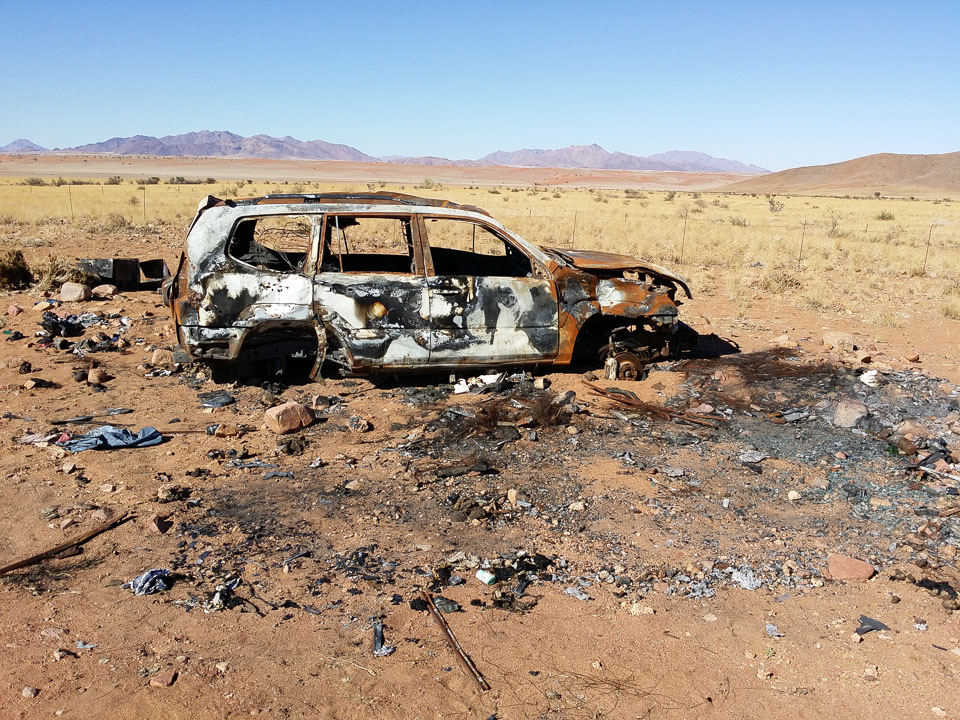 Burnt-out vehicle next to gravel road near Sossusvlei in Namibia
Burnt-out vehicle next to gravel road near Sossusvlei in NamibiaSpeed on Gravel Roads
Experience has taught us that a safe speed on gravel roads is 60km per hour. At this speed, you will be able to control most dangerous driving situations. Remember, you are on holiday and at this speed you can take in the surrounding countryside and see many things that you might miss at a higher speed. We recommend you plan your daily routing to be no further than 300km. This distance would take around 5 hours to complete.
As our roads are fairly deserted you may not encounter oncoming traffic for a long time. This could increase your confidence and your speed. Be very aware, speed is the number one killer on Namibian roads; also the road surface can change rapidly from hard surface to soft sand. This causes a vehicle travelling fast to become very difficult to control.
You may encounter locals who are carrying on their normal day-to-day business life on these roads, travelling at much higher speeds than the recommended speed. Do not get drawn into going faster because they are driving faster than you. Do not assume that local drivers know the safe speed to travel at.
Local accident statistics in Namibia are horrendous (deaths per number of vehicles are well over fifty times higher than European statistics). Please also keep in mind that when other drivers overtake you, their poor driving is a major contributor to those statistics.
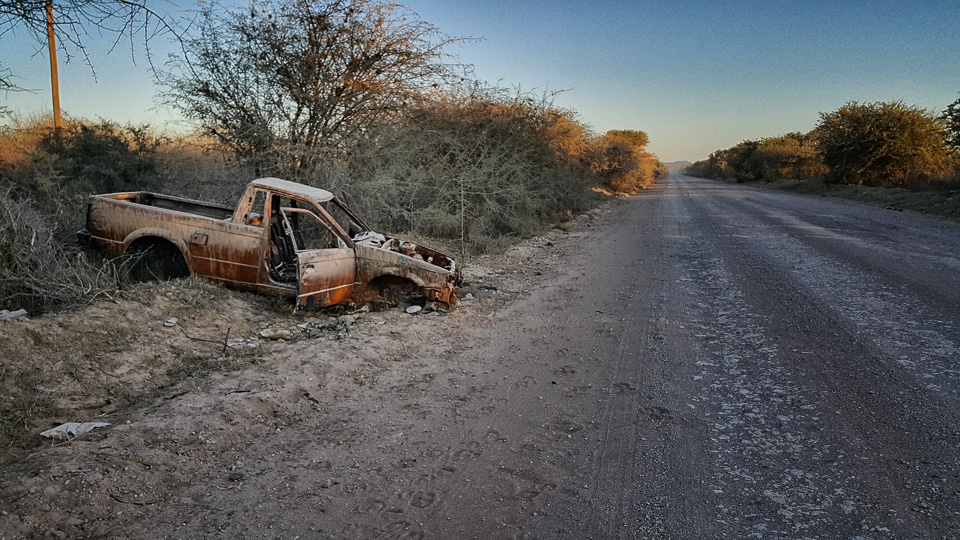 Burnt-out car on gravel road to Madikwe's Molatedi Gate.
Burnt-out car on gravel road to Madikwe's Molatedi Gate.The speed limit on tarred roads in Namibia, South Africa and Botswana is 120 km per hour, however a speed of 100 km per hour is recommended until you are familiar with the tarred roads and local traffic conditions.
Dust
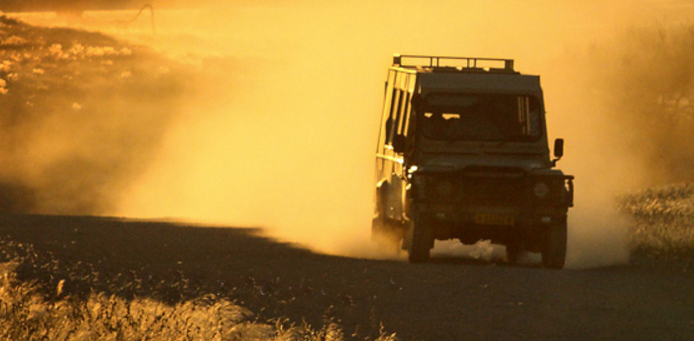 Image copyright: Kathryn Haylett
Image copyright: Kathryn HaylettIt is dangerous to travel in a vehicle’s dust cloud for various reasons, the most obvious being that you cannot see. The dust cloud could obscure corners, oncoming traffic, people, animals and a variety of other obstacles.
Overtaking
If you need to overtake a vehicle, before you change lanes and overtake, ensure that:
· there is excellent visibility
· there is no oncoming traffic for at least 1km; and
· you can see a straight road in front of you
Be alert and ensure that there is no vehicle busy overtaking you! Get back onto the left-hand side of the road after having overtaken the other vehicle.
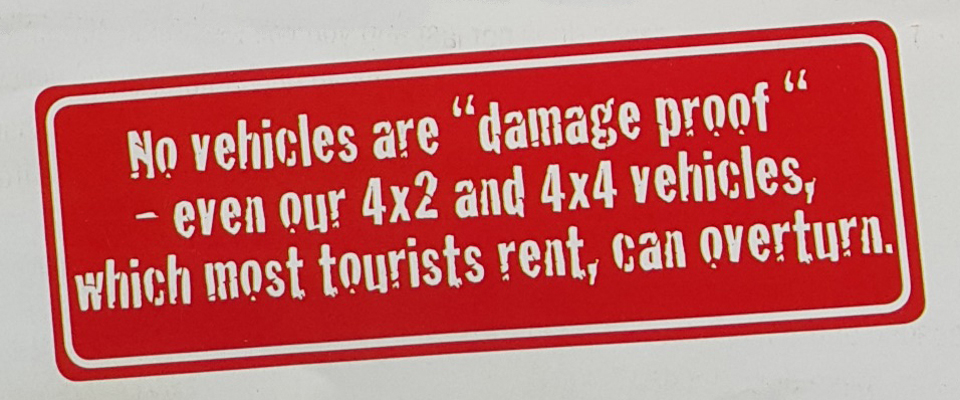
Tracks
You must stay in the tracks wherever possible,
while driving on gravel roads to avoid damaging the tyres. As previously
mentioned the stones on the side of the tracks are generally sharp and can
damage the sidewalls of the tyres.
|
Photographer's Guide to Etosha "Your time and money are valuable and the information in this book will help you save both." - Don Stilton, Florida, USA |
Photographer's Guide to Pilanesberg "This work is so much more than an eBook, because it is also a guide, a tutorial, an inspiration and a must-have for anyone interested in wildlife photography" - Findtripinfo.com, USA |
|
Photographers Guide to Kgalagadi "This eBook is packed with knowledge that can be applied to other parks, safaris and wildlife excursions via the photography lessons and additional advice for photographers" - Amanda Ellis, Pretoria, South Africa |
Photographers Guide to the Greater Kruger National Park "It's 768 pages of the most amazing information. It consists of, well, everything really. Photography info...area info...hidden roads..special places....what they have seen almost road by road. Where to stay just outside the Park...camp information. It takes quite a lot to impress me but I really feel that this book, which was 7 years in the making, is exceptional." - Janey Coetzee, founder of CAROK (Camps and Roads of Kruger) |
Distances
Distances are great and you need to remember that it does not pay to speed to a destination, as this can expose you to unnecessary danger.
Statistics show that most accidents occur between 14h00 and 17h00 in the afternoon, due to people wanting to get to their destination. Watch out for loss of concentration and keep your speed down to 60 km per hour. Remember; rather get to your destination late than not at all.
Do not let the empty roads tempt you to drive faster.
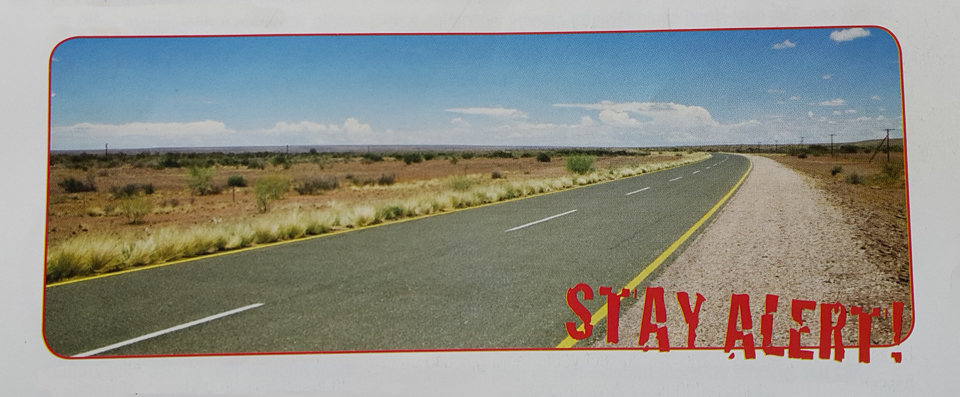
Keep Left
When you have been on the road for a while you could be drawn to the right side of the road:
· maybe this is the side you drive on at home; or
· maybe the gravel surface on the right side of the road looks more stable, and you do not see oncoming traffic.
Please keep to the left hand side of the road at all times!
Tarred Roads
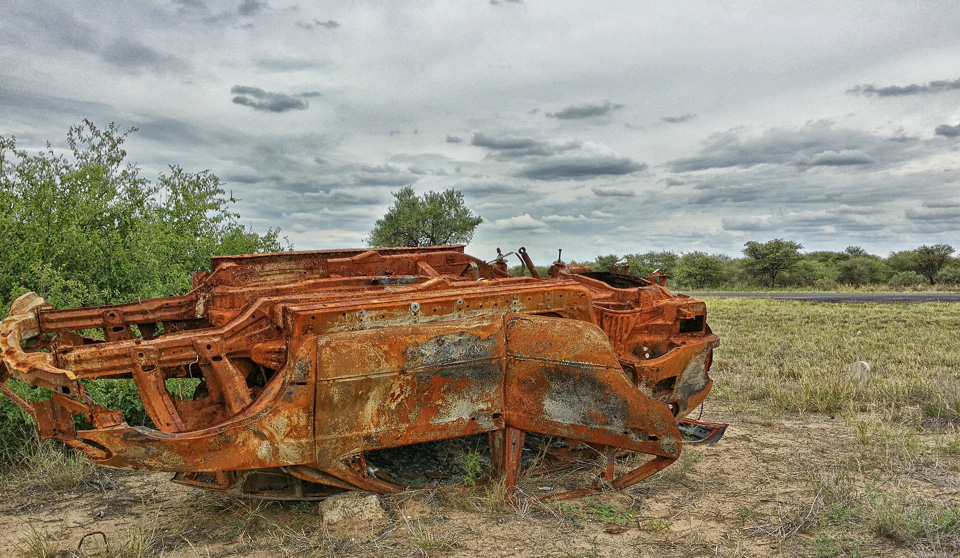 Burnt-out car on Trans-Kalahari highway, which is all tarred - watch out for animals, especially at night!
Burnt-out car on Trans-Kalahari highway, which is all tarred - watch out for animals, especially at night!Distances between towns, even on tarred roads, can be very tedious and tiring – especially when driving into the rising or setting sun. It also becomes tedious when you have been on the road for a while, so take regular breaks to stay awake and alert. Remember that you could come across an animal or end up in an uncontrollable situation at any moment.
The tarred roads are in excellent condition but conditions are very different from most other countries due to wildlife and vastness of our country.
Animals
Namibia is a large game park and farming country with poor or non-existent roadside fencing. You can be assured of seeing wild and domestic animals on your journey through the country. Most of these animals traverse roads, crossing from one grazing spot to another.
Wildlife is still abundant and is largely unpredictable, so if you do see animals, slow down and approach them carefully. Keep a sharp look out and enjoy the sight of animals in their natural surroundings. Do not swerve to avoid the animal – a lot of rollovers occur when drivers are trying to avoid animals.
· Kudu: A large buck-like animal, very shy and easily frightened. They graze next to the road (at night) because of the better quality of grazing. Therefore be especially cautious at sunset and night. The kudu’s skin does not reflect light making them difficult to see, even with headlights on full. Headlights tend to blind them, and the shadows cast, frightens them. This makes the kudu run and jump unpredictably – often into the road.
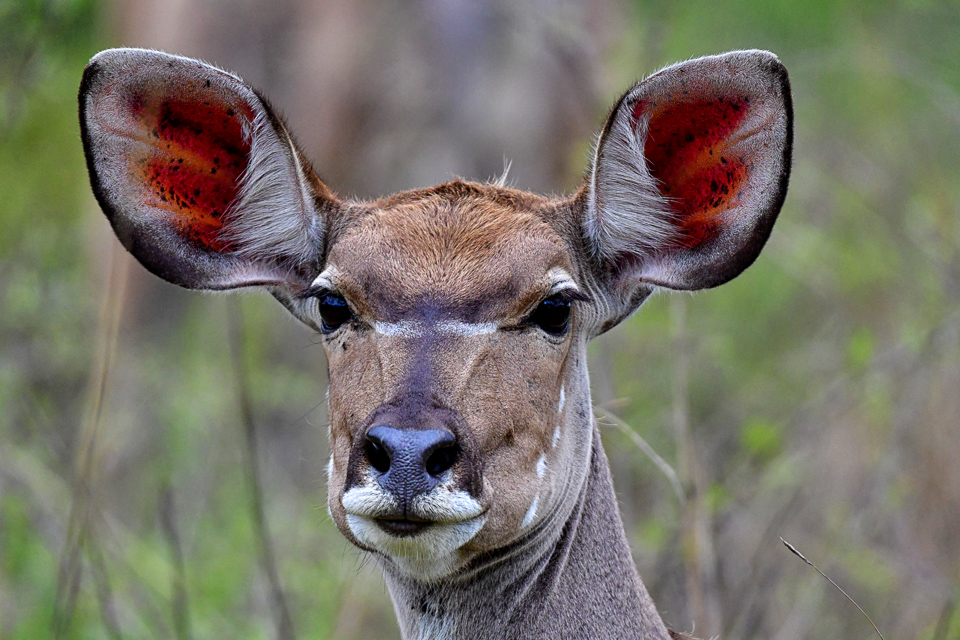
· Warthog: Members of the wild pig family, these smaller cousins are very prevalent in Namibia. Due to their small size, these animals are often hidden by the long grass on the roadside and are therefore only spotted at the last moment. This can cause you to swerve, resulting in an accident. Be constantly aware of this danger and be prepared to slow down quickly.
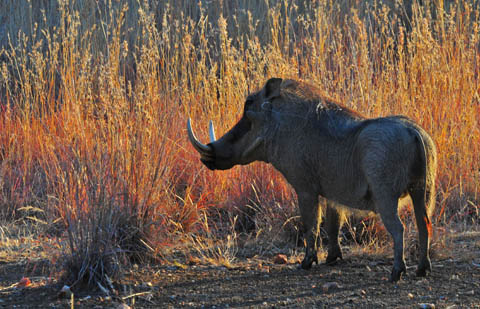
· Guinea Fowl: These chicken-like birds are often found pecking at the roadside and are easily frightened by oncoming traffic. As they are heavy birds they are not nimble and take a while to get airborne, or move out of the way. Therefore they often cross the roads by flying at low altitude and end up hitting windscreens. Locals refer to these birds also as flying bricks – so be aware!
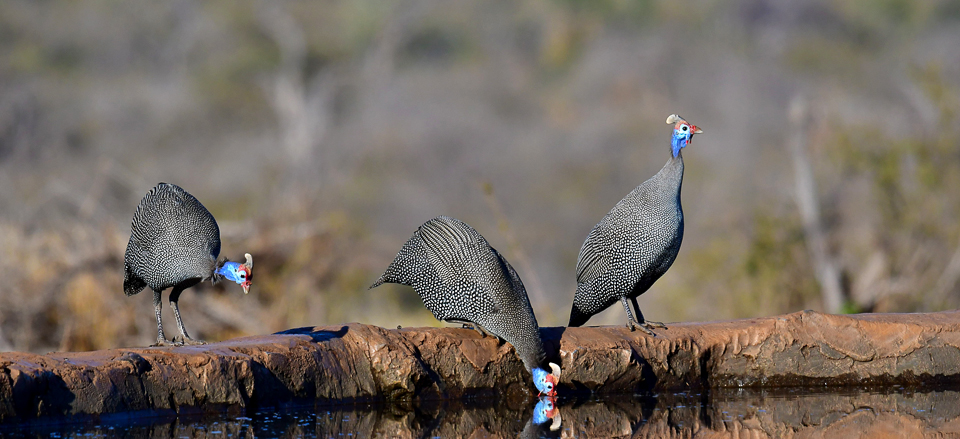
· Domestic animals: Domestic animals are often left to wander unattended and they become hazards on the roads. Most often these include cows, sheep, goats, horses, dogs and donkeys. They are most prevalent in the rural areas where fences are poorly kept and/or totally absent. Most of these animals are accustomed to vehicles and do not move out of the way. So be alert, slow down and give them a chance to get out of your way.
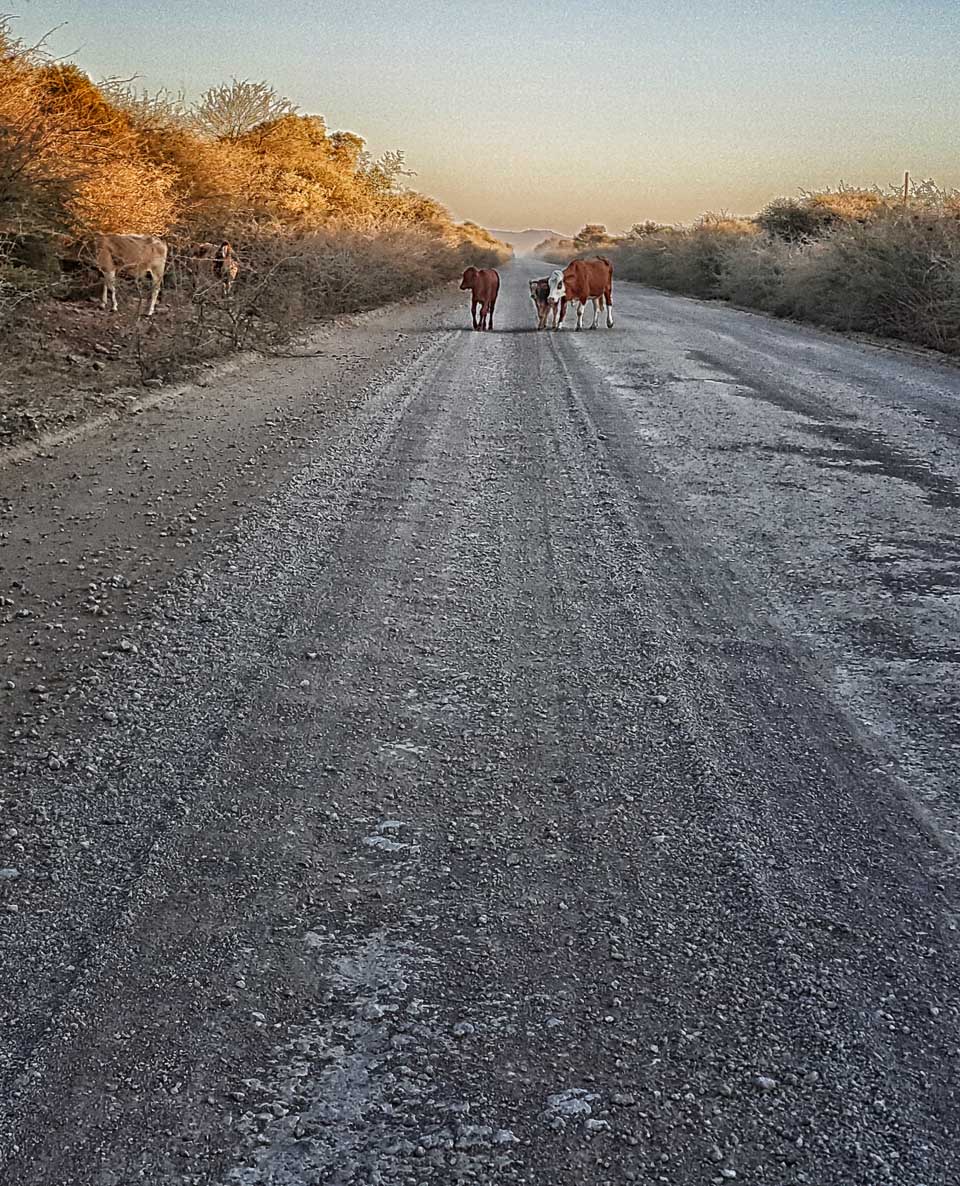 Cows in gravel road approaching Molatedi Gate of Madikwe Game Reserve.
Cows in gravel road approaching Molatedi Gate of Madikwe Game Reserve.Tyres
It is your responsibility to always check the condition of the tyres. You should inspect them when first collection the vehicle and then at every opportunity thereafter. The tyres must be in good condition before you start a trip. It is also your responsibility to look after the tyres while you are enjoying your holiday.
· Tyre air pressure: plays the most important role in the road handling ability of your vehicle. Please check the recommended air pressure and the condition of the tyres regularly. Tyre maintenance is critical for a safe journey, so please inspect the following regularly:
· Tyre tread: Ensure that the tyre tread is running off evenly and that the tyre tread has a profile of at least 3mm.
· Bulges and cuts: Ensure that there are no bulges or cuts on the sidewalls of the tyre as these substantially weaken the structure of the tyre.
· Pressure: Ensure that your tyres are inflated to the recommended pressure; as per the tables in the vehicle manual, or stuck in the driver’s door, or inside the fuel flap. Please remember to reduce the tyre pressure by 20% for driving on gravel roads. This is the most important thing that you should check before you start driving in the morning or afternoon – even if you have just stopped for a short rest stop. Be aware that most vehicles are supplied to you with the tyres inflated for the normal weight load.
· Side walls: As already mentioned, ensure that the sidewalls do not have any cuts or bulges in them. The sidewalls are the weakest part of any tyre, even though they are reinforced to strengthen them. If the tyre is under-inflated, more of the sidewall is exposed to the sharp stones on the roads due to the tyre profile bulging out.
Vehicles
The rental vehicle supplied to you has gone through a rigorous checking process to ensure that it is in peak condition for your journey. Ensure that you know what fuel it uses:
· unleaded petrol; or
· diesel
Ensure that you know where the vehicles fuel filter is situated, that you fully understand the controls of the vehicle and that you know where the spare tyre and tools are kept.
Off-road
Normal sedan type vehicles are not suited to off road conditions, so avoid damage by keeping to the roads. Bear in mind that if damage occurs while driving a vehicle in conditions that are not suitable for the vehicle you may be held responsible for any damage.
Even though gravel roads are mostly suitable for sedan type vehicles, we strongly suggest that you make use of a 4x4 off road or sports utility vehicle if your journey includes large parts of gravel road. Road conditions sometimes change and roads become impassable. Please always inquire about upcoming road conditions at your last lodge or accommodation establishment.
Do not attempt to negotiate impassable roads with a sedan type vehicle, you will get stuck and damage the vehicle.
Seasonal Rain & Rivers
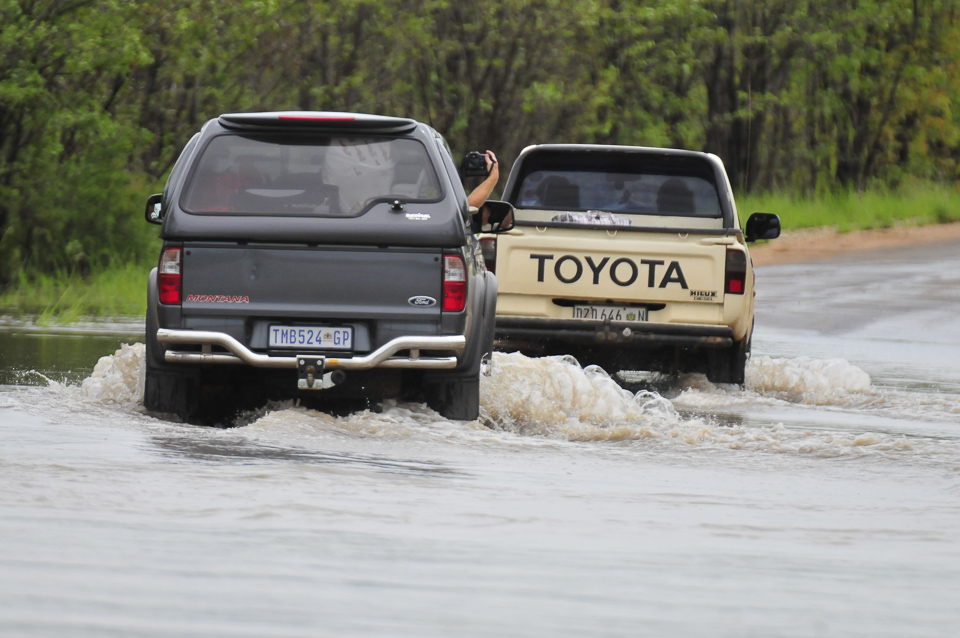 Tar road in Kruger Park under flood conditions!
Tar road in Kruger Park under flood conditions!When it rains in Namibia, it often pours, and rivers and flash floods quickly develop. Do not attempt to cross a river that has formed across a gravel road. Get out of your car and use your good judgment regarding crossing – if in doubt do not cross as you do not know how strong the current is, or what holes have developed, or what rocks have been exposed.
Many people underestimate the power of what looks like a small river – we have seen this all too often even in the heart of Namibia’s capital, Windhoek, where a flash flood develops after a heavy downpour and a river runs across a tar road. People attempt to drive through and are either swept away or stall their vehicle, which quickly fills up with water preventing occupants from getting out. Instances like these are also commonplace throughout our country.
Theft
Although Namibia has a relatively low crime rate, tourists are often targeted, as in any part of the world, because of their inexperience, or ignorance of the criminal aspects. Do not tempt passers-by to steal your belongings by leaving them where they are visible, even small change can cause a break in.
Always secure your belongings by placing them in the trunk or in the cubbyhole. Always lock your vehicle, even when driving. Always keep your travel documents on your person.
Be aware of city centers, as cameras, jewelry, purses, etc. are favorite targets for muggers.
In the National Parks
These Self-drive Travel Guidelines also apply inside the national parks and game reserves as there is a constant procession of animals like this elephant roadblock...
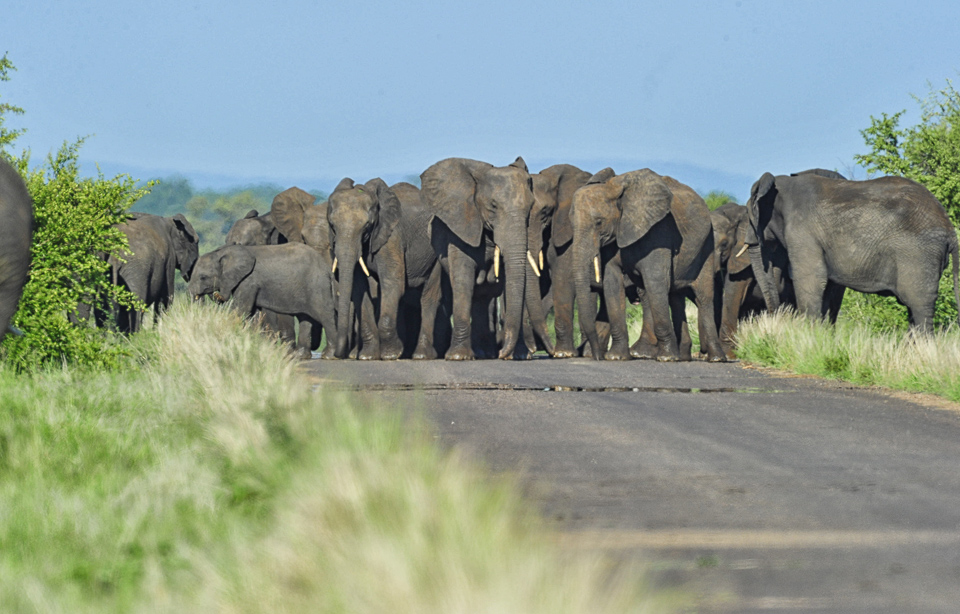
and these baboons...
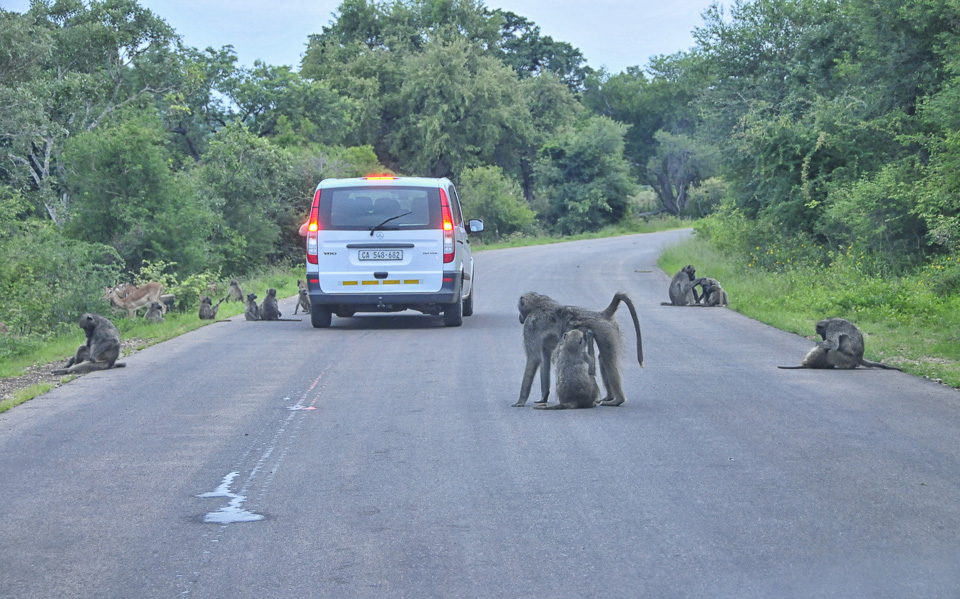
In addition to your safety you need to consider the safety of animals - this black-backed jackal was the roadkill victim of a driver who was not paying attention to the road in Namibia...
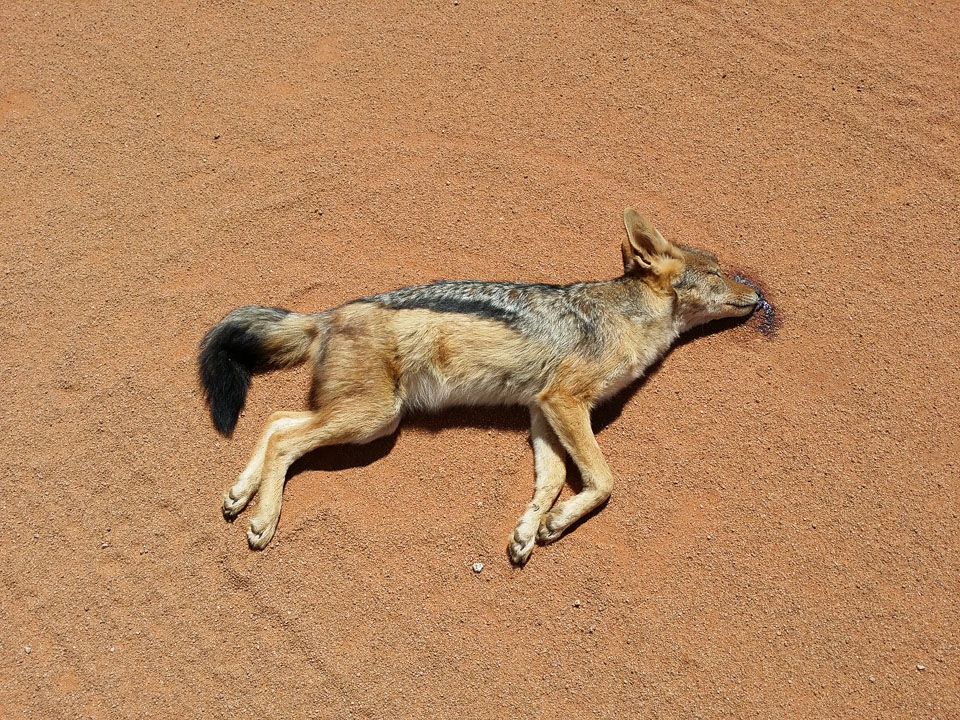
The speed limit inside the parks is considerably less than outside the parks:
Etosha: 60 kms
Kruger Park: 50 kms on tar and 40 kms on gravel roads
Madikwe: 40 kms
Pilanesberg: 40 kms
Kgalagadi Transfrontier Park: 50 kms
Inside the camps the speed limit is 20 kms.
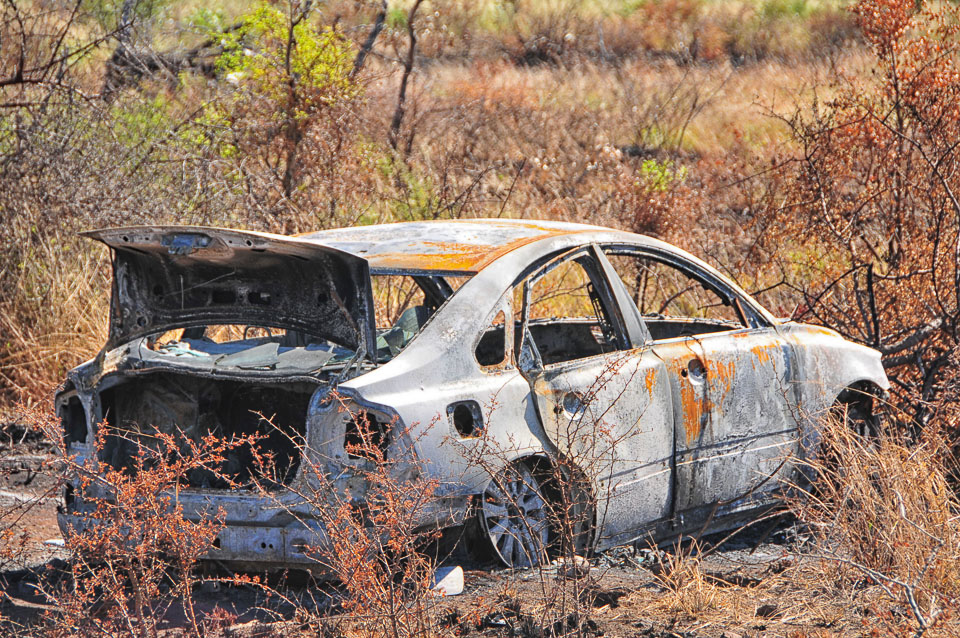 Car near Satara in the Kruger National Park - yes, there are accidents inside the national parks and game reserves!
Car near Satara in the Kruger National Park - yes, there are accidents inside the national parks and game reserves!The focus of these self-drive travel guidelines is for the self-drive visitor but you need to also be alert and aware when on guided game drives as well.
We had an accident while on a guided game drive at Jacis Safari Lodge in Madikwe - both Jenny and I were injured and our photo gear damaged due to the driver's negligence yet the lodge management were not interested and showed no empathy or sympathy. You can read more here.
None of the above is meant to scare you; it is intended to help you to not become part of the road accidents statistics. A self-drive journey through Namibia or any Southern African country, can be a very fun, exciting and safe holiday, if you stick to the above self-drive travel guidelines and safety tips.
Return from Self-drive Travel Guidelines to Safari Car Hire page
Return from Self-drive Travel Guidelines to K2K home page
To make a safari rental booking in South Africa, Botswana or Namibia click here
"It's 768 pages of the most amazing information. It consists of, well, everything really. Photography info...area info...hidden roads..special places....what they have seen almost road by road. Where to stay just outside the Park...camp information. It takes quite a lot to impress me but I really feel that this book, which was 7 years in the making, is exceptional." - Janey Coetzee, founder of CAROK (Camps and Roads of Kruger) South Africa
"Having a passion for the region itself and having to know about all dynamics, water holes and ideal roads for a period of 6 years - I wish I had this guide on my first trip already!" - Morkel Erasmus, Secunda, South Africa
"Mario and Jenny take you to places that are not always visited, and their descriptions of the more remote camps will allow you to make an informed decision without wasting time and money" - Bob & Sherry Shepardson, DeBary, Florida, USA
"Your time and money are valuable and the information in this book will help you save both." - Don Stilton, Florida, USA
"I highly recommend the book to anyone visiting Etosha National Park to photograph the animals - or anyone considering an African photography safari in the future." - Anne Darling, Cognac, France
"As a photographer and someone who has visited and taken photographs in the Pilanesberg National Park, I can safely say that with the knowledge gained from this eBook, your experiences and photographs will be much more memorable." - Alastair Stewart, BC, Canada
"This work is so much more than an eBook, because it is also a guide, a tutorial, an inspiration and a must-have for anyone interested in wildlife photography" - Findtripinfo.com, USA
Photo Safaris on a Private Vehicle - just You, the guide & the animals!
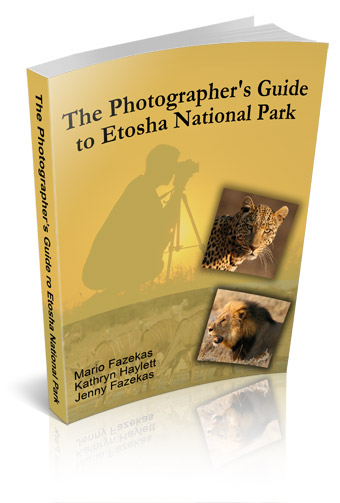
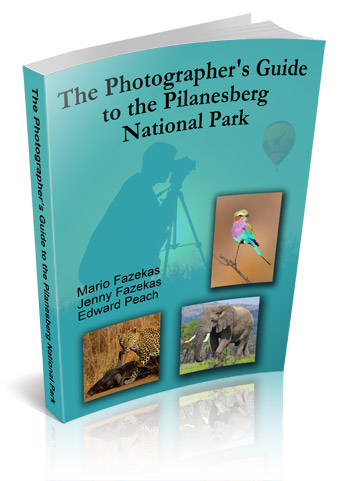










New! Comments
Have your say about what you just read! Please leave us a comment in the box below.